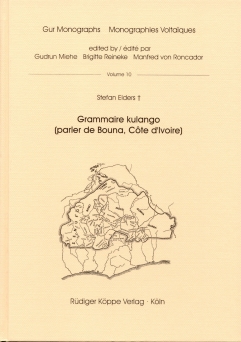
Grammaire kulango (parler de Bouna, Côte d’Ivoire)
Author: Stefan Elders †. Edited by: Gudrun Miehe, Pascal Boyeldieu. Series edited by: Gudrun Miehe, Brigitte Reineke, Manfred von Roncador.
Series: Gur Monographs · Monographies Voltaïques Volume 10
200822 pp. Roman, 648 pp.
1 map, 1 b/w photo, numerous charts, appendix
Text language(s): French
Format: 170 x 240 mm
1260 g
Hardcover
€ 69.80
Buy 'Grammaire kulango (parler de Bouna, Côte d’Ivoire)' as a downloadable PDF document directly from our online shop »
Order 'Grammaire kulango (parler de Bouna, Côte d’Ivoire)' as print edition »
Kulango is spoken in the Northeast of Côte d’Ivoire, in the Zanzan region, as well as in neighbouring Ghana, in the Brong Ahafo region. It is separated into two major dialect groups, the northern branch centring around the village of Bouna in the East of the Parc National de la Comoë. The southern variant is concentrated around the settlements of Bondoukou, Tanda and Nassian. There are some 142,000 speakers of the Bouna variant in Côte d’Ivoire and 15,500 in Ghana, while about 70,000 people in Côte d’Ivoire and 27,000 in Ghana speak Bondoukou-Kulango. A third, minor dialect called Nabay is isolated to two villages in the Northwest of the Parc National de la Comoë. Kulango is part of the Gur language family, a sub-branch of the Niger-Congo languages. With Teen and Loma, so-called Loron languages spoken in the border region of Côte d’Ivoire and Burkina Faso, it forms the Kulango-Loron subdivision of Gur.
This grammar focuses on the Northern dialect of Kulango as spoken in the village of Bouna, the historical centre of the Kulango kingdom described by Boutillier (1993). According to the informants it is the more conservative variant of the language. The result of numerous research trips to the area in the years 2000 and 2001, this present work offers a synchronous description of phonology, morphology and syntax of the language under description. Some aspects of word formation processes are described, as well, putting them into context with other Gur languages.
About the author:
On February 19th, 2007, Stefan Elders died after suddenly and violently falling ill during field reasearch in Mali. On this day, the African linguistic community lost one of its most committed and talented researchers. His last efforts are to be honoured with this publication.
Under these links you will find further publications of the author and an obituary:
Accompanying material:
- Noun Class Systems in Gur Languages I
(ISBN 978-3-89645-119-4 ) - Noun Class Systems in Gur Languages I + II
(ISBN 978-3-89645-619-9 ) - Proceedings of the 4th WOCAL World Congress of African Linguistics, New Brunswick 2003
(ISBN 978-3-89645-338-9 ) - Zwischen Bantu und Burkina
(ISBN 978-3-89645-348-8 )
Cross-reference:
- Les langues gur (voltaïques)
(ISBN 978-3-89645-111-8 ) - Les peuples voltaïques (gur)
(ISBN 978-3-89645-114-9 ) - Migration and Conflict
(ISBN 978-3-89645-903-9 ) - Zerrissene Entfaltung
(ISBN 978-3-89645-202-3 )
Reviews
A compendious book of this nature is most likely to be used for reference on particular topics, than read through or explored for ideas. The author is careful to define the major technical terms relevant to each chapter, but he does not engage in extended argument. [...]
In sum, the book represents a very considerable contribution to the linguistics of West Africa, and is a fitting monument to its author.
Mary Esther Kropp Dakubu in Journal of African Languages and Linguistics, 32/1, 2011, 146-150
PDF documents:
 | Obituary Dr. Stefan Elders | (≈ 306 kB) |
| « back | Print version | [top] |
 Books
Books Audio
Audio Biographies
Biographies Series
Series Festschrifts
Festschrifts Journals
Journals